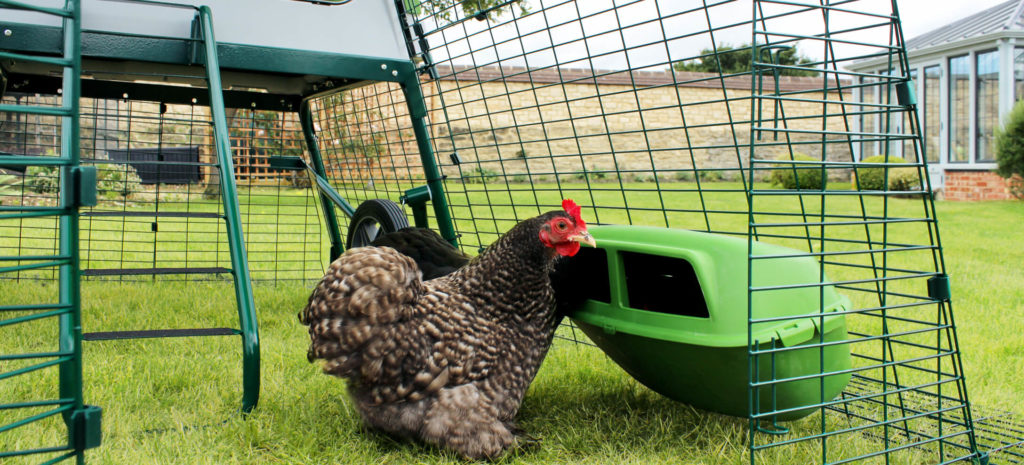
Important update on 19th March 2021 from gov.uk:
“The risk of avian influenza to both wild and kept birds has reduced to ‘medium’. The Avian Influenza Prevention Zone (AIPZ) requiring enhanced biosecurity will remain in force but Wednesday 31 March 2021 will be the last day poultry and other captive birds will need to be housed (housing restrictions end 23:59 31 March 2021). Bird gatherings are still prohibited. High standards of biosecurity remain essential as infection may still be present in the environment.”
Important update on 3 December 2020 from gov.uk:
“The Chief Veterinary Officers for England, Scotland and Wales have agreed to bring in new measures to help protect poultry and captive birds. The new housing measures announced on the 3 December 2020, which will come into force on the 14 December 2020, mean that it will be a legal requirement for all bird keepers to keep their birds indoors and to follow strict biosecurity measures in order to limit the spread of and eradicate the disease.”
Avian Flu is an issue that affects all chicken keepers. Efforts to contain the virus never result in its eradication, and the fact that it is not currently in the headlines doesn’t mean it’s disappeared. Many countries are enduring the avian flu version of lockdown in certain regions this year, and people are being told to take appropriate measures.
There have been local outbreaks in the UK, Germany, Denmark and the Netherlands in the second half of 2020. The current avian flu strain in Europe is a low pathogenic avian influenza, meaning that it is highly unlikely to spread from its bird hosts to humans. The ghost of a bird flu pandemic cannot be ignored, though.
The outbreak is thought to have originated in western Russia and Kazakhstan, following the same pattern as the avian flu outbreaks in the summers of 2005 and 2016. In both previous cases, epidemics soon spread to northern and eastern Europe.
This article describes the impact of pathogenic avian influenza, how it spreads, and what chicken keepers can do to prevent it, based on government guidelines and other practical measures.
What is avian flu?
As its name suggest, the avian flu virus is a form of influenza (flu) biologically adapted to bird hosts. Bird flu is not a virus specific to chickens and poultry, and in theory any bird, wild or domestic, can be infected. The reservoir of avian influenza is, indeed, flocking wild birds such as geese and gulls.
Symptoms of avian flu in chickens
Chickens with avian influenza will display various symptoms. They may be less active than usual, and will lose their appetite and show signs of nervousness. Their egg production will drop, and eventually their combs and wattles will look swollen, with a blue discoloration. Other avian influenza symptoms in poultry include coughs, sneezes and diarrhoea. Unfortunately, many of these bird flu symptoms are associated with other ailments, too, so a vet will need to make the diagnosis.
It can take 14 days for an avian influenza outbreak to spread throughout a flock. Some infected birds may exhibit no signs, even though they are still potential virus carriers. Others may ail and die very quickly.
How to treat avian flu in chickens
You can reduce the risk of avian influenza in your poultry by following the latest guidelines issued by Defra and the government. Vaccination of a flock at risk from the avian influenza virus is the only method of prevention. If avian influenza affects a flock, the flock has to be put down. Links to the latest UK government advice is given at the end of this article.
How to protect your chickens
- Place your birds’ food and water in fully enclosed areas that are protected from wild birds, and remove any spilled feed regularly.
- Keep your equipment clean and tidy and regularly disinfect hard surfaces.
- Clean footwear before and after visiting your birds.
- Ensure clothing that you use when handling your chickens is washed after contact.
- Use run covers to protect your chickens’ enclosure from wild bird droppings.
- Keep moveable coops in the same place – if coops are moving to fresh ground there is more chance of coming into contact with wild bird faeces.
- Keep a close eye on your chickens. If you have any signs of illness, seek advice from a qualified vet.
Areas in the UK affected by avian flu in 2020
The latest cases of avian influenza virus amongst chickens and other poultry occurred in the Melton Mowbray region of Leicestershire in November 2020, with the other affected areas located south of Liverpool and in the Leominster region of Herefordshire. There are 10-kilometre exclusion zones in place at these locations, and there are dozens of other areas observing a 3-kilometre exclusion zone based on the risk from wild birds. The Department for Environment, Food and Rural Affairs (Defra) has an up-to-date interactive avian influenza map showing all the areas affected by restrictions in England, Scotland and Wales. Not surprisingly, areas adjoining the island’s various estuaries, firths and The Wash, are affected, and anyone keeping chickens in these areas needs to be up to date with the latest government advice and regulations.
The UK government recommends registering your hens (and any other poultry), which will ensure that you receive the latest advice regarding the flu. If you keep over 50 hens, registration is a legal requirement, as you are then, by definition, a poultry farmer. Farmers who do not comply with regulations regarding avian flu can be imprisoned for up to three months or face unlimited fines.
“The risk of HPAI incursion in wild birds in the UK is HIGH. The overall risk of infection of poultry in the UK is MEDIUM; although it should be noted that the risk of introduction to individual premises depends upon the level of biosecurity implemented on farm to prevent direct or indirect contact with wild birds.”
(Official advice about biosecurity can be found here: https://www.gov.uk/guidance/avian-influenza-bird-flu#biosecurity-advice)
“Bird flu is a notifiable animal disease. If you suspect any type of bird flu in poultry or captive birds you must report it immediately by calling the Defra Rural Services Helpline on 03000 200 301. In Wales, contact 0300 303 8268. In Scotland, contact your local Field Services Office. Failure to do so is an offence.
If you find dead wild waterfowl (swans, geese or ducks) or other dead wild birds, such as gulls or birds of prey, you should report them to the Defra helpline (03459 33 55 77 – please select option 7).”
*Advice correct as of 25th November 2020.
This entry was posted in Chickens on November 26th, 2020 by chloewelch

While all cats are different, there are certain traits common to most felines. Most cats, for example, are united in the things they dislike. Unfortunately, a lot of the things cats dislike are things that humans do to them, often unaware how much their cats hate it.
To guide cat owners towards more feline-friendly behaviour, here are the top ten things humans do that cats wish we wouldn’t.
1. Cats hate loud noises
A cat’s ear is designed to channel sound, and their hearing is much more acute than a human’s. This means that washing machines, shouting, music and phones – not to mention fireworks and family parties – are all things cats hate. Being respectful of a cat’s sensitive ears may help minimise the problem, but cats are also very good at escaping the loud noise and finding somewhere quiet. It is only when the noise is unescapable – fireworks, for example – that the cat’s stress can really mount.
2. Cats don’t like aggressive petting
While some dogs may enjoy a rough back-scratch or enthusiastic belly rub, most cats prefer a gentler approach. Heavy-handed pats, stroking and paw- or tail-handling will make cats feel in danger, and they will either run, lash out with their claws or simply become stressed. Many cats dislike being cuddled, a condition that has a name – feline hyperesthesia. This is particularly common in rescue cats, so always take care when petting your cat – watch its reactions and don’t force the issue. Dressing cats up in supposedly cute outfits falls into this category, too. Make sure everyone in the household, including the children, is aware of these kitty rules.
3. Some cats don’t like to be ignored
While not all cats crave attention, many domestic cats love it – on their terms, and when it suits them. A cat who doesn’t want to be left alone and wants you to stop doing what you’re doing and give them some attention will jump onto your lap or desk and generally get in the way of your hands. In an age of laptops and home-working, many cat owners are very aware of this feline attention seeking, and the demanding pet cat sometimes seems to be a permanent feature of the desk, computer keyboard or sofa!
4. Cats don’t like water
The fact that cats hate getting wet is such a well-known fact that it has become a cliché, but that doesn’t stop it being true! Cats avoid water, hide from the rain and simply hate being showered. As far as a cat is concerned, that all-purpose tongue is quite capable of delivering the perfect cat shower. You should only resort to cat baths or showers when absolutely necessary –to clean something toxic or oily from the fur, or to prepare a cat for a show.
 5. Cats hate car journeys
5. Cats hate car journeys
Felines often hide under cars when they’re afraid, but most of them do not like car rides at all, and some cats are terrified by vehicles. The combination of motion, loud noises and strange smells is stressful for a cat, and they are also prone to motion sickness. Car journeys should therefore be restricted to necessities – for example, trips to the cat vet or to the cat hotel when you’re going on holiday.
6. Cats dislike other pets
Although a kitten that has been brought up with other cats, or even dogs, will tolerate their company, cats need their own territory, and they are also natural loners. Unlike humans – and unlike many breeds of dog – cats do not need a significant other in their lives. You only have to watch how cats react to other cats in their territory – in the garden, for example – to see how true this is.
7. Cats hate taking medication
You can fool a dog by wrapping a slice of ham around its tablet or mixing its medicine into the food bowl. Cats are more resistant to our efforts to make them feel better, though. Giving a cat tablets involves a coating of butter and some gentle throat massage.
8. Cats won’t use dirty litter boxes
Cats are very clean animals, and will not use a dirty litter box. Regular cleaning of the tray is therefore essential, and fresh kitty litter needs adding regularly to keep everything smelling nice and fresh. People often ask “what smells do cats hate?”, and the answer “cat wee and cat poo” is high on the list (along with air fresheners, incense and peeled citrus fruits!)
9. Cats should never be given physical punishment
This is one that a cat is unlikely to forgive a human for. A cat should be dissuaded from unwanted behaviour by making a not-too-loud noise, such as hitting your hand with a rolled up magazine or clapping (but, again, remember that they dislike loud noises too). Any physical chastisement will break the bond of trust between cat and owner.
10. Cats need their own space
A cat’s bed, favourite hidey-hole or quiet corner of the garden should be areas where humans never intrude. Children need reminding of this, as their instinct may be to pluck the cat from its bed and give it a cuddle. Once again, cats have a territorial nature and need their own quiet spots and safe zones, where they can unwind.
Knowing what a cat likes and what a cat dislikes is one of the keys to avoiding pet peeves and keeping your cat happy and healthy. One of the key takeaway messages is that cats are not like humans or dogs. They are cats – unique and purr-fect.
This entry was posted in Cats on November 26th, 2020 by linnearask

Fido Studio in White
Is someone in your family getting a new puppy that they are planning to crate train? Or have your parents got a nervous rescue dog that feels most secure when they have their own space away from all the hustle and bustle? Then we have the perfect gift for them, human or canine.
The amazing Fido Studio is a dog crate that looks like piece of modern furniture, so that it doesn’t have to be hidden in a corner somewhere. The Fido Studio is also available with an optional and extremely practical wardrobe where all the dog’s things can go!Save 10% on white Fido Studios in the Winter Sale!
Bolster Beds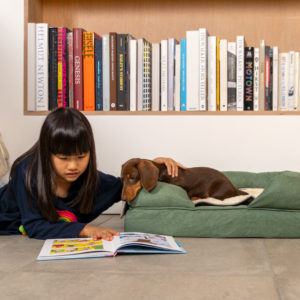
Whether you’re buying for a dog or a dog owner, an upgraded bed will always be appreciated, especially if the current one is looking a bit dirty and chewed. The super comfortable Bolster Beds come with a memory foam mattress that moulds itself around the dog as they lie down on it. Perfect for everything from growing puppies to older, more tired dogs.
The Bolster Bed has a machine washable cover, comes in three sizes and colours, and can be purchased with a set of stylish feet. And at the moment all beds are 20% off!
Psst – cats love them too!
Blankets / Cooling Mats
Upgrade your dog’s bed for Christmas to make sure it’s ready for the year ahead. Omlet’s super soft blankets will make the bed extremely warm and cosy for your pet after long winter walks, and is perfect for putting on sofas or car seats to keep them free from hair and mud. And if you already want to get ready for 2021, the Cooling Mat is a perfect addition to a dog bed in spring and summer. This self-cooling mat is activated by the weight of your dog’s body, and will minimise the risk of overheating on warm days.
Cooling mats are 20% off, and Blankets 15% off in the Winter Sale!
Click here for full terms and conditions.
This entry was posted in Dogs on November 22nd, 2020 by linnearask

2 x 2 Outdoor Rabbit Run
Any rabbit owner looking for more space for their pets will be delighted to receive this 2×2 Outdoor Rabbit Run. The run is extremely stable and secure, and can be connected to an existing Eglu Go Hutch with or without run with a simple connection kit.
This is perfect if you, or the person you’re buying a gift for, want to give rabbits or guinea pigs a bit more space to play on in the garden. Choose between the full or low height, both are currently 10% off in the Omlet Winter Sale!
Zippi Tunnels, Play Pens & Runs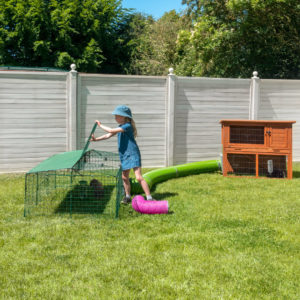
Zippi is the perfect way to enhance your pets’ life. The amazing tunnel system allows you to create a burrow-like path in your garden that your rabbits and guinea pigs will love exploring. Expand with corners and T-junctions, and add intrigue with hayracks and lookout towers!
The Zippi Tunnel System also makes it super easy for your pets to independently move between their hutch and a remote run or playpen, so that they can come and go as they want throughout the day.
This is the perfect opportunity to extend an existing system, or to start a completely new one! All Zippi Tunnel System parts are discounted by 20% in the Winter Sale, and the Zippi Run and Playpens are currently 10% off!
Caddi
The Caddi is the perfect stocking filler for any small animal lover. This interactive treat holder can be hung from the roof of any hutch or run, and can be filled with fresh vegetables or hay for rabbits and guinea pigs to enjoy.
It’s super easy to refill, will keep the pets’ snacks fresher for longer, and they will love the challenge of the swinging Caddi as they go in for a bite!
Save 15% on the Caddi right now!
Click here for full terms and conditions.
This entry was posted in Gift Guides on November 22nd, 2020 by linnearask

Eglu Cube / Eglu Go / Eglu Go UP
This is the ideal time to treat yourself to that chicken coop you have been dreaming about! If would like to start keeping chickens in the new year, the Eglu Go or Eglu Go UP are brilliant starter coops for 3-4 hens. If you currently have a smaller Eglu, or keep chickens in a coop that is starting to look a bit worse for ware, you might want to consider investing in an Eglu Cube, our largest chicken coop with space for up to 10 small bantam hens.
All Eglus are super safe, very easy to clean and can be moved around the garden as often as you like. This makes life easier and more relaxing for both you and your pets!
Eglu Chicken Coops are currently discounted by up to 20% in our Winter Sale!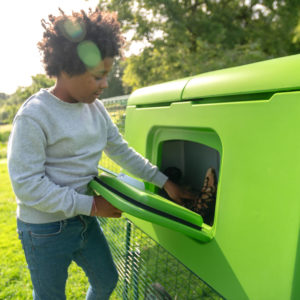
Chicken Accessories
Omlet’s amazing range of Chicken Toys and Accessories make great Christmas gifts for chicken keepers of all ages. Interactive food toys like the Poppy and Pendant Peck Toys and the Caddi Treat Holder that can be filled with fresh veg and hung from the roof of the run will entertain chickens during the cold winter months, as will the super fun Chicken Swing and the more traditional Chicken Perch.
All these accessories are currently significantly discounted, so why not take the opportunity to get the whole hentertainment bundle?
Boughton
If you’re planning to treat a traditionalist that prefers to keep their hens in a wooden chicken coop this Christmas, we’ve got just the house for you. The timeless, yet practical, design of the Boughton makes it easier to keep chickens happy and healthy, and any chicken keeper will enjoy seeing the coop in the garden every morning. It also comes untreated, so that the person getting this very generous gift can decide what look they would like to go for!
The Boughton is now 15% off in the Omlet Winter Sale!
Click here for full terms and conditions.
This entry was posted in Chickens on November 22nd, 2020 by linnearask

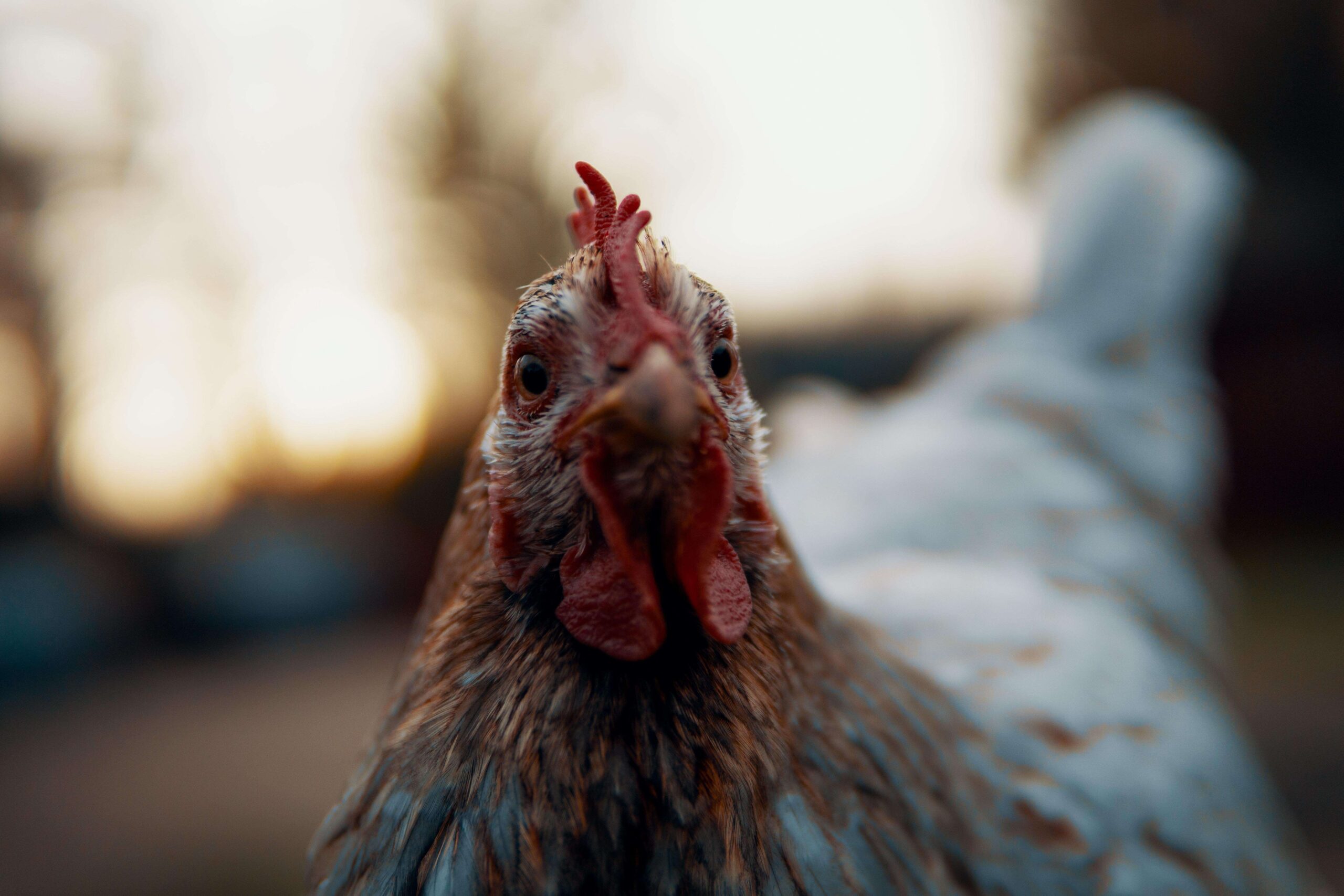
Only very tame pet hens enjoy being picked up. Most chickens find the whole procedure stressful, so you should only catch or handle them if you have to.
There are a few reasons why you might need to know how to catch a chicken. Your hens might be in danger, might require a clean-up after coming into contact with something oily or sticky, or you might need to carry out a chicken health check.
There are various ways to catch a chicken. If the hen is in danger as a result of escaping onto a road or into a garden with a dog in it, you can usually manage things by ‘herding’ the chicken rather than trying to lift it. If a dog is the problem, controlling or confining the dog is the first thing to sort out. If the hen has escaped and you need to catch her, guiding her back to safety by standing with your arms stretched out to the sides and encouraging her to return to the chicken coop is the best option. In these situations, the chicken will desperately want to find her fellow hens, so ‘steer’ her towards the hole in the fence or the open gate, or whichever escape route she took.
If the hen has flapped over a wall, however, you may have to resort to old fashioned hunting techniques for catching chickens.
How Do You Catch a Stray Chicken?
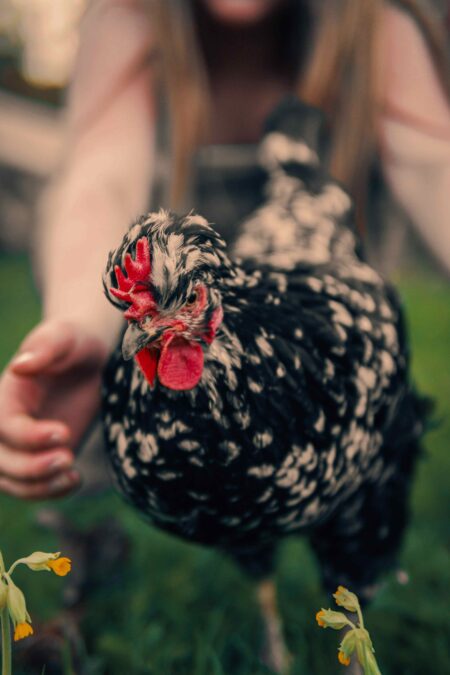 If your hens are very tame, you can simply offer some treats, bend down and pick them up. If only it were that easy with every chicken! Some are about as easy to catch as a fast-moving bar of wet soap – they can sprint at speeds of around 9 miles (14.5 km) per hour – and you will usually have to corner them first if you want to catch them.
If your hens are very tame, you can simply offer some treats, bend down and pick them up. If only it were that easy with every chicken! Some are about as easy to catch as a fast-moving bar of wet soap – they can sprint at speeds of around 9 miles (14.5 km) per hour – and you will usually have to corner them first if you want to catch them.
If a hen has escaped or you spot her running away, or simply hidden somewhere in a large garden or meadow where you can find to trace of her, the best approach is to be patient and rely on the chicken’s homing instinct. As dusk begins to fall, the hen will instinctively head back to the coop. This is one of the handy things about keeping poultry!
The Best Way to Catch a Chicken
Do chickens like being picked up? In general, the answer is no. But if you’re trying to catch a chicken for whatever reason there are various ways of doing so. Not all of them can be recommended for the non-expert chicken keeper.
- Using a net to catch chickens. Nets can be dangerous tools, as a chicken’s claws can snag in the netting, causing injury. If you opt for this method, the chickens should be netted as quickly as possible to minimise stress – although forever afterwards the sight of that net will send the poor hen into a panic! You should always use as large a net as possible for catching your chickens. A blanket may offer a safer way to catch them.
- Using crate traps for catching chickens. Putting irresistible treats into a crate, and then slyly closing the door with a pole or long stick is an effective method. The main drawback is that all the other chickens will be tempted to take a look inside too!
- Boxes for catching chickens. A large box can be placed over a cornered bird in the coop or run, and the flaps can be tucked in to secure the chicken. This technique can be useful if you need to capture chickens in daylight (although it works at night, too) and if they tend to be aggressive.
- Torchlight makes chickens easier to catch. This is the simplest and most effective method when you need to trap a roosting chicken. When chickens are with the rest of the flock in the coop or run on their roosting bars or perches or in their nesting boxes at night, they instinctively stay put. If you open the top of the coop and shine a torch in (head-mounted ones are perfect), you’ll be able to pinpoint the hen you need to examine, and grab her up with minimal fuss.
Picking Up the Chicken
When picking up the hen, try to be firm but not rough. Getting a good grip and preventing the wings from flapping is the key. The correct method is to hold the chicken by placing your hand over its back, confining the wings, and then bring it close to your body. If the bird is very nervous, you may have to cover her with a towel to calm her down.
A tame hen is the easiest type of chicken to capture. Simply lure the hen in with a few treats, and grab her, stroking her back to reassure her. Once the cleaning or the examination is over, put the chicken on the ground and step back. She will do the rest, scuttling back to the safety of the flock.
So, there are several ways to catch a chicken, but you should only put them into operation when you definitely need to catch one. Try to avoid the poultry hook or net if you can, and use the method that suits both the chicken and the circumstances.
This entry was posted in Chickens on November 18th, 2020 by linnearask

Moving house is stressful for everyone involved – and that includes pets and chickens. As far as your hens are concerned, the secret to a successful relocation is to have everything ready at the other end. In the same way as you might unpack a kettle and two mugs before opening any of the big boxes, the chicken shed and run should be ready in the garden before the first kettle boils!
Hens are prone to stress, and at the very least you can expect the egg count to plummet for a few days following a move. Weak or very nervous chickens are in particular danger, as panic can make them flap blindly and break legs, or even kill themselves. Minimising stress is therefore the key to a successful move.
The most stress-free way to get your hens ready for the move is to collect and crate/box them from the coop, rather than later in the day when they are out and about and need chasing and cornering. That is not a good way to minimise stress!
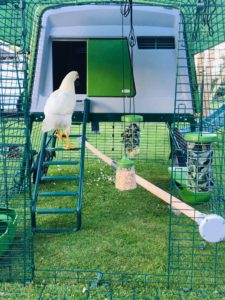 Transporting Chickens
Transporting Chickens
Your hen-carriers need to be covered, well-ventilated boxes or pet crates. They should have enough space for the birds to turn around in (to prevent them from panicking at the confined space), while being dark enough to make their instincts kick in and help them snuggle down for the duration of the trip. On longer journeys, however, you will need to have enough light in the boxes to enable the hens to feed, and pet crates will make this easier.
You’ll need one box per chicken, generally, so make sure you have enough boxes for the big day. Hens with similar, placid temperaments can be transported in a single box. Each box or crate should be lined with straw to soak up the droppings, and the boxes should be stacked securely, not more than three boxes high.
It’s important that the birds don’t get too hot on the journey, so ventilation is an issue. If you only have two or three hens, they could travel on the back seat of a well-ventilated car, secured with quilts or blankets – or even seatbelts – to prevent the boxes from sliding around.
The journey itself should be taken using as many straight, non-bumpy roads as possible, combined with the need to make the trip as brief as you can. If your new home is a short stretch of motorway and a couple of A-roads away, that’s all very straightforward. Rural locations with lots of windy-road options will need more planning. If all the roads are B-roads with lots of bends, the quickest route is the best option.
In the two weeks before the move, make sure your hens’ diet is rich in all the required vitamins and minerals. Some owners recommend adding probiotics or extra vitamins to the feed, and this is something you should discuss with your vet.
For short journeys, you will not have to worry about chicken feed. On longer trips, though, food will need to be provided. Make sure you take a long break at least every three hours, to allow the confined birds to settle down and feed. If you are transporting the hens in crates, you can attach a water dispenser to the side.
A Portable Chicken Coop?
Old fashioned chicken coops can be tricky to transport, and many hen keepers prefer to erect a new run and chicken shed at their new property. This sometimes involves housing the birds in temporary accommodation while the new coop and run are being sorted out.
There are ways of avoiding the inconvenience, though. A portable coop and run can be packed away and then installed in the new garden in a few minutes, and they have the advantage of familiarity. Hens introduced into a coop that they already know inside out will reduce the stress of the move enormously.
Coops and runs such as the Eglu are ideal in this respect. Placing the coop in your new garden as soon as you arrive will enable the chickens to feel at home before you’ve even managed to open any of your removal boxes. Human will inevitably feel the stress of the moving-in process, but the hens don’t have to!
The process isn’t quite over when your hens are safely cooped up in the new garden. Stress can cause any underlying diseases to bloom, so you need to carry out daily health checks on your birds as the flock settles down in its new surroundings. This is yet another reason to consider a pack-and-go portable coop and run.
This entry was posted in Chickens on November 11th, 2020 by linnearask
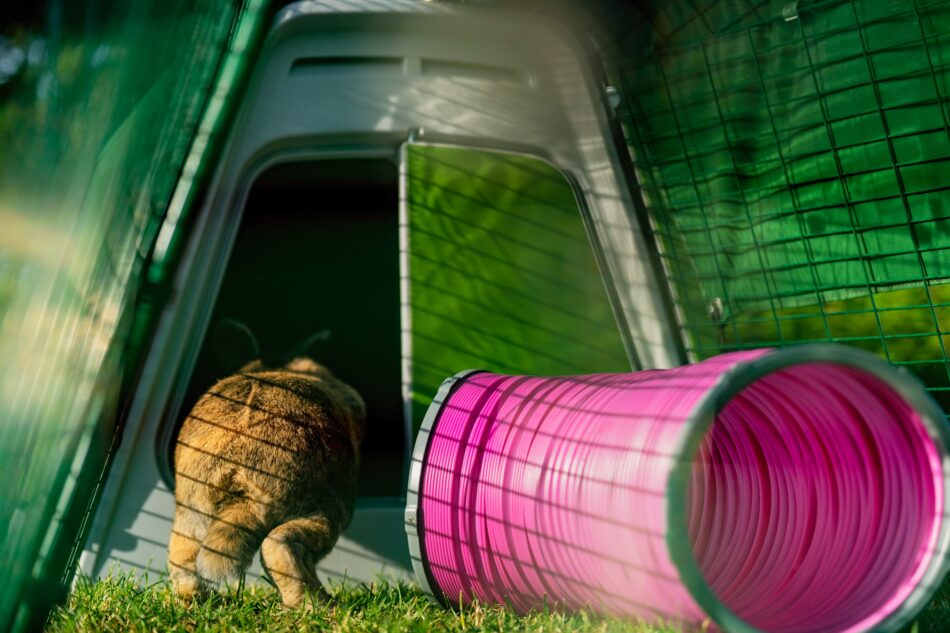
Rabbits make great family pets, and there are many different breeds to choose from. Some are easier to care for than others, making them ideal choices for beginners or children. Other breeds can prove more challenging to care for, but can be enjoyed by more seasoned rabbit-owners. So, which is the best rabbit for you? We’ll outline our top picks.
Children and rabbits
Although they make good pets for kids, rabbits might be disappointing as a first-time pet for young children. This is because most rabbits aren’t fond of being picked up and carried around, and can cause accidental injury to both themselves and children due to their powerful back legs and sharp claws. But, this isn’t to say that rabbits can’t be good pets for children.
Because bunnies need a gentle and practised hand, it’s best for parents or older siblings to be the ones handling them. Younger children can enjoy sitting with, petting, helping feed, and observing pet rabbits, making rabbits good pets for children of all ages.
5 best rabbit breeds to own
We aren’t trying to play favourites, but there are a few rabbit breeds that stand out as ideal choices for first-time rabbit owners. Their overall personalities, low-maintenance grooming needs, and basic housing requirements make these breeds great options for families.
Mini Lops
Big floppy ears, but with a compact, easy-to-house stature, Mini Lops are a favourite among first-time rabbit owners and breeders alike. They have outgoing personalities, and are known for being good with children. Mini Lops have short-medium coats that don’t require much grooming, and top out between 4.5-6 pounds. They’re easily trained and are social with other rabbits and humans.
Holland Lops
Similar to their cousins, Holland Lops have floppy ears and small bodies. Their faces are more flat than Mini Lops, and their ears are shorter and more rounded. Holland Lops weigh 4 pounds or less when they’re full grown, but have lots of energy. They’re social and enjoy interacting with humans and other rabbits, but need plenty of space to exercise. Because of their energetic nature, Holland Lops prefer to play with their owners rather than be carried around — but they’ll enjoy a good snuggle.
Lionheads
As their name suggests, Lionhead rabbits have tufts of hair encircling their heads that appear like a lion’s mane. While they do have extra hair that requires brushing from time to time, Lionheads have small bodies that weigh between 2.5 and 3.5 pounds when full-grown, making them perfect handling size. In fact, Lionheads are known as “lap rabbits”, and actually enjoy being held and handled. Their sweet, laid-back personalities make them a favourite among families.
Himalayans
Himalayan rabbits have a striking appearance — white bodies with dark points and pink eyes. They grow to be between 3 and 5 pounds, and have short hair that is easy to groom. Himalayans have long been appreciated for their calm and patient personalities. They don’t mind being handled, and are one of the oldest domesticated breeds of rabbits, making them well accustomed to human interaction. Himalayans are easy to train and care for.
Harlequins
A medium breed weighing up to 9 pounds, Harlequin rabbits are stunning in appearance and are curious and outgoing. They love learning tricks, and respond to praise from their owners. Harlequin rabbits should have plenty of space to expend their energy, and thrive off of human interaction. Their size may make them slightly more difficult for children to handle, but their desire to please makes it easy to train them to come when called and accept being petted and held.
Basic bunny care
No matter which breed you choose, all rabbits have the same basic needs. Before bringing your rabbit home, be sure to have:
All rabbit breeds thrive best when they’re given as much space to play and explore as possible. The addition of Zippi Rabbit Tunnels and Zippi Rabbit Playpens broadens your bunnies’ territory and fosters their natural desire to burrow, scurry, and play.
Bunnies need buddies
In addition to their housing, rabbits need companionship. Two neutered males, a neutered male with a female, or two females are all successful combinations. The younger the rabbit, the easier it will be for them to bond with another bunny, but it’s possible to introduce two grown rabbits for a lasting relationship. Rabbits are social animals, and their interactions with each other won’t interfere with the bonds made with their humans.
Consider adopting a bonded pair of rabbits, or obtaining two young rabbits at the same time when starting out. A lonely rabbit may become depressed or act out, so providing your bunny with a buddy will make it easier for you to build a bond with them.
Omlet and your rabbits
Building bonds between you and your bunnies is at the forefront of our designs. Our Eglu Go Rabbit Hutch has everything you and your rabbits need to keep them safe and happy, while our line of Zippi Rabbit Tunnels and Zippi Rabbit Playpens enable you to watch and play with your rabbits in an environment that mimics nature — making your relationship with them as unique as their individual personalities.

This entry was posted in Rabbits on November 9th, 2020 by linnearask
Meet five pawsome stars from our exciting new video, and find out more about their new favourite dog bed: Topology!
Topology is a super stylish, comfortable and practical bed that both dogs and owners will love! Machine washable toppers zip on and off the supportive memory foam mattress, so that your dog’s bed can easily be kept clean and hygienic. The range of five different toppers also means that you will be able to customise the bed to fit your dog and their personality.
We asked five of the canine characters in the Topology video to tell us which topper was their favourite and why:
Freddie love his Topology Dog Bed with a comfy Beanbag topper

Freddie is a boisterous Dalmatian with bundles of energy! He loves showing off his jumping skills, and will happily throw himself at his bed over and over again to burn off some steam. This isn’t a challenge for the robust fabric and stitching of the Topology Dog Bed, and Freddies favourite topper, the Beanbag, is both fun and super comfortable as it fully lets the dog’s body relax as they lie down on top of it.
It doesn’t happen often, but sometimes even Freddie needs a good, long nap, and as much as the Topology dog bed can withstand his lively playing, it will also provide superb support for his resting body. Thanks to the memory foam layer in the base and the softness of the topper, Freddies owners have no doubt he’s fully relaxed and comfortable when he finally settles in for the night.
Woody could relax for days on his Topology bed with luxurious Sheepskin topper

Even if neither he nor his owner would admit to it, Woody the Goldendoodle is what many would describe as a pampered pooch. He won’t settle for anything but the most luxurious of dog beds after his strolls around the city’s parks, so it’s no surprise that his favourite topper is the sheepskin.
Positioned in the best position in the living room, Woody can stretch out on his Topology Dog Bed and feel the super soft fabric against his skin while the memory foam mattress moulds around his body. Woody’s owner really appreciates how easy it is to remove and clean the topper.
Winston feels safe and supported on his Topology dog bed with Bolster topper

Little Winston is a Dachshund, and only six months old. With all the exciting exploring, learning, playing and chewing shoes he has to do all day, it’s extra important that he has a comfy bed to retreat to when he gets tired.
Winston absolutely loves the bolster topper. Not only does the perfectly padded bolster give his little head support when he snoozes, it also encloses the body to provide a den-like feeling that adds a sense of security.
Margot favours the elegance and extreme comfort of the Quilted topper

Margot is a classy Afghan Hound who appreciates the simple luxuries in life. She loves being comfortable, preferably curling up by the fire after a walk around the town when she enjoys meeting new dogs to sniff.
Margot’s favourite topper is the super soft quilted version. It stays cool against the body in summer and has a warming effect in winter, and the classic design oozes luxury and comfort. Additionally, Margot’s owners love the look of the soft minty grey against the rest of their furniture!
Esme can dry off and relax on the Microfiber topper on her Topology Dog bed

Esme is a perfectly sized terrier mix who loves nothing more than running over wide fields and chasing squirrels between trees on long country walks. Rain and wind won’t stop her – the muddier the better! That’s why the microfiber topper is her favourite. The structured fabric is nice to roll your wet back against, and it will speed up the drying process.
Esme’s owners also love that she’s got a space to dry off after inevitable hose-downs that isn’t the living room carpet! Leftover mud and moisture from walks will quickly and smoothly blend into the microfiber topper, and it can be washed over and over again, allowing for more lovely nature walks.
Read more about Topology here
This entry was posted in Dogs on November 6th, 2020 by linnearask

In many ways dogs age in similar ways to humans. Older dogs have less energy, lose some of their senses, experience changes in sleeping and eating patterns, go grey and can have trouble remembering the most ordinary things.
Additionally, muscles and bones become weaker, and the immune system is not as good at fighting off infections. Internal organs also get more tired, so the dog is more prone to liver, heart and kidney disease.
This may seem rather gloomy and depressing, but it’s just a part of nature we have to accept, and as long as you as an owner continue to care for your dog in an appropriate way as they get older, you can really enjoy the last golden years together.
What counts as a senior dog?
Not all dogs reach old age at the same time. Just as with humans, some dogs seem a lot younger or older than their actual age, and genetics play a part in the risk of developing diseases and problems with hearing and sight.
But the most important thing when figuring out when your dog will be a senior is size. Toy dogs, terriers and other small breeds are seen as old when they are 10-11 years, medium-sized breeds like retrievers are considered seniors when they are 8-10 years, and large and giant breeds reach old age at 5 or 6.
 What can I do to help my dog in old age?
What can I do to help my dog in old age?
Your dog will still need regular exercise, even if it might look a bit different from when they were young and bouncy. Accept that the dog won’t be able to come on the long walks they used to love, and try exercising for shorter periods of time more often. Remember to also stimulate your elderly dog mentally. Food toys and puzzles will be great for keeping your dog’s brain sharp.
Older dogs that don’t move around as they once did run the risk of excessive weight gain, and their diet will need to be adjusted to fit their new energy levels. Ask your vet for advice on what to feed your senior dog, but in general it’s good to choose a low fat feed and limit the amount of treats.
Make sure you take your dog to the vet for more regular check ups as he or she gets older. That way you will be able to spot potential problems early on. Dental hygiene is more important than ever, and it’s common that the skin gets drier and the coat less shiny, so it might be a good idea to do a bit more grooming.
Changing sleeping habits
Long gone are the puppy days when your dog passed out anywhere and slept for hours. Comfort is super important for older dogs, and their tired muscles and bones will need support.
Choose a dog bed that is designed to look after the dog’s body, ideally with a firm but supportive mattress and a soft cover. Omlet’s Bolster Dog Beds are great for senior dogs, not only because of the high performing memory foam mattress and supportive features, but also because they can be raised off the ground, making it much easier for an older and less agile dog to get in and out of the bed.
It’s also important to be aware that senior dogs often are much more sensitive to temperature changes. Place the dog’s bed somewhere that stays warm in winter and cool in summer, and provide them with an extra blanket in winter and maybe use a cooling mat in summer.
Making the right decisions at the end of life
There might come a time when you as an owner will have to make unpleasant decisions regarding your dog’s health and potentially whether or not your pet’s life is worth living.
If your dog develops an illness that can be treated, you will need to consider what the interventions will be like for the dog, what their quality of life will be after the treatment, and how long it may extend their life. If you have insurance, money hopefully doesn’t have to be a factor to consider, but many operations and treatments are extremely pricey and far from risk free.
Remember to try and put your own feelings to one side and concentrate on what is best for your dog. Although you might be able to get another few months together with your pet, he or she might be in constant pain, and will not be able to do all the things they used to love, and will not enjoy themselves.
Older pets can easily struggle with anxiety. Their body and mind are changing, and they can’t figure out why. Even if your dog might not be able to see or hear you as well as they used to, they can sense your presence, and that will make them calm and happy, so try to spend as much time together as possible. The last few years of your dog’s life can be a wonderful time for both of you, so don’t dwell on aging but take them for a walk, snuggle up with them on the sofa and play with them – just like you’ve always done!
This entry was posted in Dogs on November 5th, 2020 by linnearask
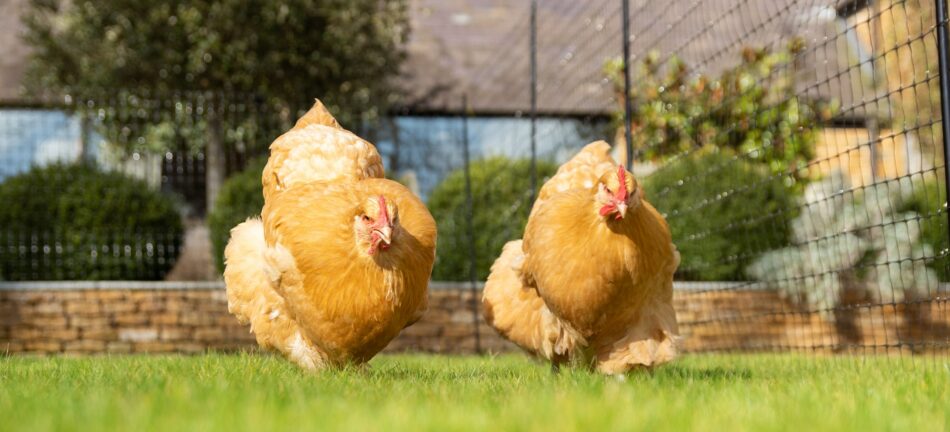
As with all pets, chickens rely on their owners for their safety and wellbeing. But as humans, vacations, spontaneous trips, and other time away from home are inevitable. So how will your chickens manage while you’re away?
Chickens are fairly self-sufficient, and do well when left alone. They don’t have separation anxiety from their owners like some pets experience, and can entertain themselves as long as they have their flock for company. Chickens will also regulate their feed intake and not overeat if free-choice food is left out for them. Still, they are prey animals, and certain considerations need to be taken into account before you take an extended leave of absence – particularly if no one will be staying with them while you’re away.
How long can I leave my chickens alone for?
Every chicken keeper does things a little differently from another, so the amount of time you can spend away from your flock is largely dependent on how you have them setup. Do they free-range, or are they always in a coop and run? Do you have an automatic door to tuck them in at night? Do you leave feed out, or feed them a portion daily?
When you prepare your chickens for your absence, you’ll need to make sure they have access to plenty of food and water. You’ll also need to make sure that they stick to their regular schedule as closely as possible. If they’re accustomed to free-ranging during the day and being closed in at night, you’ll need to have a safe, contained space large enough to simulate free-ranging.
An Eglu Cube chicken coop connected to a walk in chicken run is a great option for chickens that are accustomed to free-ranging, or for flocks that crave space during their time out of the coop. The run can be extended to however large you’d like to make it, so space is never an issue. And with the anti-dig skirting, predators will be deterred from coop-crashing while you’re away!
Give the setup and routine that you plan to have while you’re away a trial run before you leave to make sure everything goes smoothly. If any changes need to be made before you leave, you’ll want to give your flock ample time to adjust. Chickens will adapt quickly, so if your trial run was a success, your chickens should be just fine if you’re gone over the weekend.
Should I get a chicken sitter?
Leaving chickens alone for a day or two is commonplace for most flock-raisers, but if you are gone longer than that, it’s a good idea to have someone come and check on your chickens while you’re away. Depending on the time of the year, chickens can go through their feed and water quickly, and one misplaced step or a visit from some neighbourly mice can empty a food or water container in a hurry!
Consider asking a neighbour or a family friend that enjoys chickens to stop by and check in with your hens. A quick glance is often all it takes to ensure your flock is thriving while you’re away. You can always offer for them to take whatever eggs your hens have laid while you’re away as repayment and token of your (and your hens’) thanks!
If you have an automatic chicken coop door, be sure to let your chicken sitter know what time it opens and closes, or ask if they have a preferred time to go and check on your flock. Make sure to reprogram your automatic chicken coop door (if open or close times need to be adjusted) well in advance to get your hens accustomed to a different bedtime if necessary!
What do my chickens need while I’m away?
Food and water
Make sure to fill all of your chickens’ feeders and waterers before you leave. If possible, anchor any free-standing feeders or waterers to the sides of the run or coop to prevent them from being knocked over. Keep waterers sheltered from blowing debris to prevent them from getting clogged.
Prep for different weather
Consider the time of year you are leaving and plan accordingly. Always prepare for precipitation – even if there isn’t any in the weather forecast! Make sure your chicken run cover is on to provide shade and protection from rain.
Entertainment
If your flock is used to daily visits and treats from you, they will likely miss it while you’re away! To head off any treat-pining or fear of missing out on playdates, offer some fun alternatives such as a Chicken Swing or a variety of chicken toys to keep them occupied. To really stay in their good graces, set out some treats in a chicken peck toy or Caddi Treat Holder. Your flock might not even notice you’re gone!
Good to go
With proper preparation and planning, travelling can still be part of your lifestyle when you have chickens. The easiest way to maintain a flexible schedule with chickens is to create a setup that allows for flexibility from the beginning.
It’s always easiest to start off with the ideal setup for your flock so that your future travel plans don’t interfere with their routine. Large chicken coops with walk in runs, automatic chicken coop doors, and weather protection are all components of raising happy and safe chickens – whether you’re home or not!
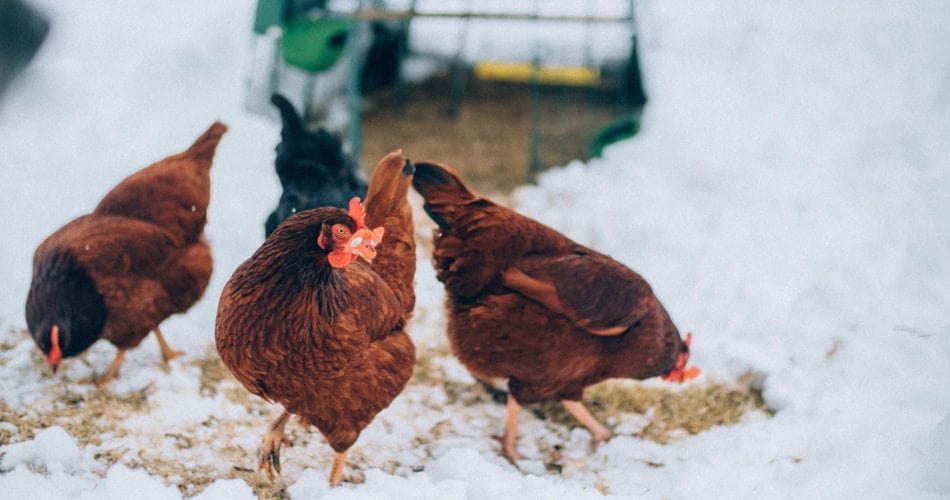
This entry was posted in Chickens on November 5th, 2020 by linnearask
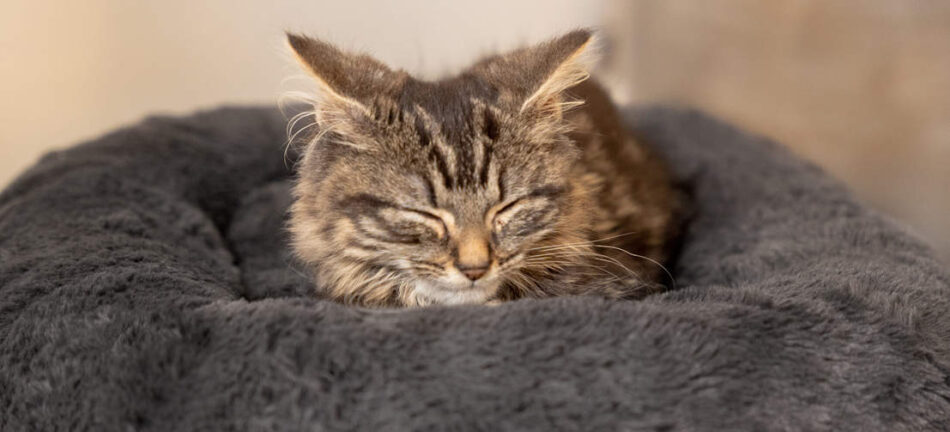
You’ve had a hectic week at work and now the car’s broken down. Sound stressful? It’s only human to let things get the better of us sometimes, and in times of trouble, we often turn to our four-legged companions to calm us down. Cats always manage to find a way to help us relax and give us something else to focus on for a moment. But do you ever think about what might potentially make them stressed? Stress is not an uncommon problem with cats. They can be anxious animals that don’t deal well with change, so there are lots of factors that might make your pet stressed. It’s not always easy to spot signs of stress, or to combat them, but it’s important to try, as chronic stress can lead to health and behavioural problems in felines.
4 common causes of stress in cats
An illness or physical trauma that requires treatment or medication will very likely make your cat feel worried. Apart from the potential pain or discomfort, the cat might also have to take pills or wear a cone, which limits their agility and freedom. Being in heat, or your cat being pregnant, will unsurprisingly make most female cats feel on edge, and it is very difficult to tell them what’s happening to their bodies. Apart from more medical conditions, grooming-related changes like having a bath or getting a haircut can sometimes cause stress in your cat.
The big ones here are moving to a new house, or spending time away from the home, like in a kennel or on holiday. Cats prefer the safety of what they know, and will most likely not enjoy traveling anywhere.
Extreme weather and seasonal changes can make cats worried and stressed, as can a lack of stimulation in their current living space. Outdoor cats who for some reason have been limited to the house will for example often develop stress-related symptoms. Another common environmental stress factor for cats is the presence of other pets, including another cat. If you’re considering adding a new feline addition to the family, first, find out how your cats can live in harmony.
Anyone unfamiliar to your cat coming into the household can be seen as a threat. Whether they’re guests who are just over for dinner or new housemates moving into the spare bedroom, this can make your pet anxious. A new baby in the house can be stressful for everyone involved – two and four-legged family members alike. This isn’t to say that cats and children cannot get along great, but what’s important is that boundaries are respected. The Maya Indoor cat house from Omlet is the ideal spot for a kitty escape, which can be placed out of reach from any disturbances. The super soft Omlet Maya Donut cat bed slots in perfectly to the cat house, too, making their hideaway the ultimate spot for catching up on cat naps.
-
Litter tray and diet factors
Changing your cat’s brand or type of litter or food can also make your cat stressed. If you plan on switching your cat’s litter, this should be done over a gradual period of time, mixing the new litter, with the old. A new litter box can also be anxiety-inducing, as can an unusually dirty tray or lack of food and water.
What can stress do to a cat?
Bursts of stress, fear or anxiety are normal and harmless, but it’s prolonged, chronic stress that can be dangerous. Like in humans, longer periods of stress are associated with depression and a weakened immune system. In cats, stress is also believed to cause or trigger conditions like feline asthma. Stress can also cause many behavioral problems such as aggression and litter tray avoidance.
How can I tell if my cat is stressed?
First of all, it’s worth noting that a cat that seems worried by a barking dog outside the window or the sudden noise of something dropping on the floor is completely normal. It’s when your cat is on constant high alert, that you should consider stress management solutions. Here’s what to look out for:
Physical symptoms of stress include, but are not limited to:
- Vomiting and diarrhoea
- Excessive shedding and/or grooming
- Changes in eating and sleeping patterns
- Lethargy
Behavioral symptoms of stress include, but are not limited to:
- Significant changes in routines or behaviour
- Urinating outside the litter tray and spraying on furniture
- Unexpected aggression towards humans or other pets
- Disinterest in things going on around them
- Excessive meowing
- Hiding for long periods of time
If you notice a change in your cat’s behaviour or physical appearance, the first thing you should do is take them to the vet to rule out any possible medical condition that could be causing the symptoms. Stress can in itself be a symptom of some diseases and illnesses, but the vet will be able to give you the best advice for your cat specifically.
What can I do to help my cat?
The most important thing to do is to try and find the source of the stress. Observe your cat’s behaviour in different situations to try and see if there are any triggers. Once you think you have located the reason/s your cat feels stressed, it’s time to solve the problem.
Offer a safe space
Firstly, make sure your cat has a safe space they can retreat to when they feel stressed or anxious. It should be a room free from disturbances, where you can place a cat den like the Maya Indoor cat house. It’s important that everyone in the family, children included, knows not to disrupt the cat when they’re in their safe space to make sure they’re able to fully relax.
Social interaction
Spending time with your cat is a good way of providing stimulation for your cat. It also means social interaction for both you and your feline friend, which is great for dealing with stress. It can be chasing after a catnip toy, watching them use their cat scratching post or just relaxing on the sofa – let your cat decide.
Look after yourself
Another thing to consider is that our pets are highly affected by our well-being. If you feel stressed, your cat is more likely to feel stressed, and if you’re relaxed they’re more likely to not see everything around them as a threat. It’s easier said than done to stop feeling a certain way, but perhaps the knowledge that your pet’s mental health could be affected, can inspire you to find new ways of managing your own stress.
Omlet and your cat’s well-being
At Omlet, we expertly design products to put your pets’ well-being first. From the Maya Indoor cat house to Stak cat scratcher, our designers know what both cats and owners need to live a harmonious and stress-free life.
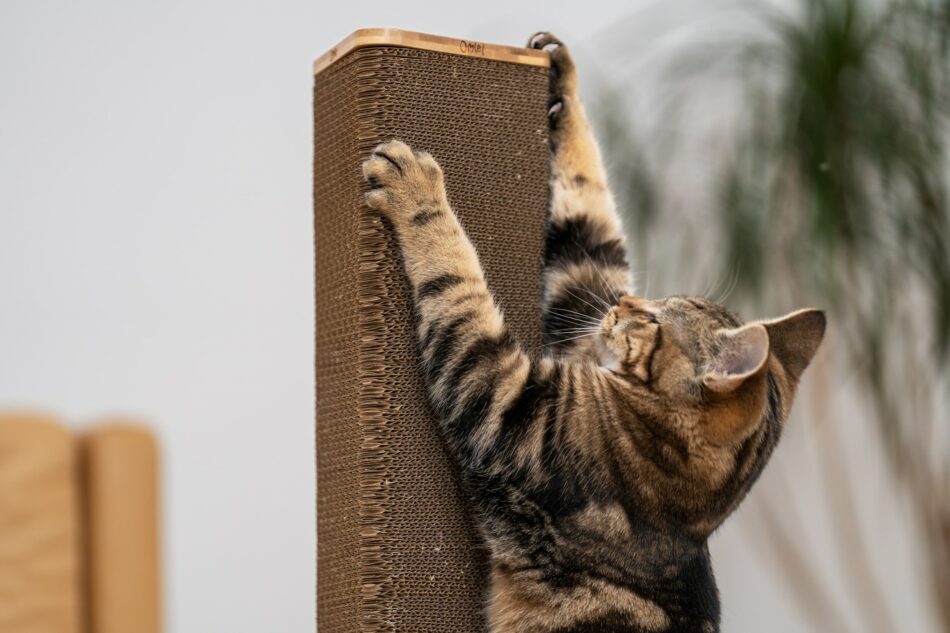
This entry was posted in Cats on November 2nd, 2020 by linnearask









 If your hens are very tame, you can simply offer some treats, bend down and pick them up. If only it were that easy with every chicken! Some are about as easy to catch as a fast-moving bar of wet soap – they can sprint at speeds of around 9 miles (14.5 km) per hour – and you will usually have to corner them first if you want to catch them.
If your hens are very tame, you can simply offer some treats, bend down and pick them up. If only it were that easy with every chicken! Some are about as easy to catch as a fast-moving bar of wet soap – they can sprint at speeds of around 9 miles (14.5 km) per hour – and you will usually have to corner them first if you want to catch them.









 What can I do to help my dog in old age?
What can I do to help my dog in old age? 


